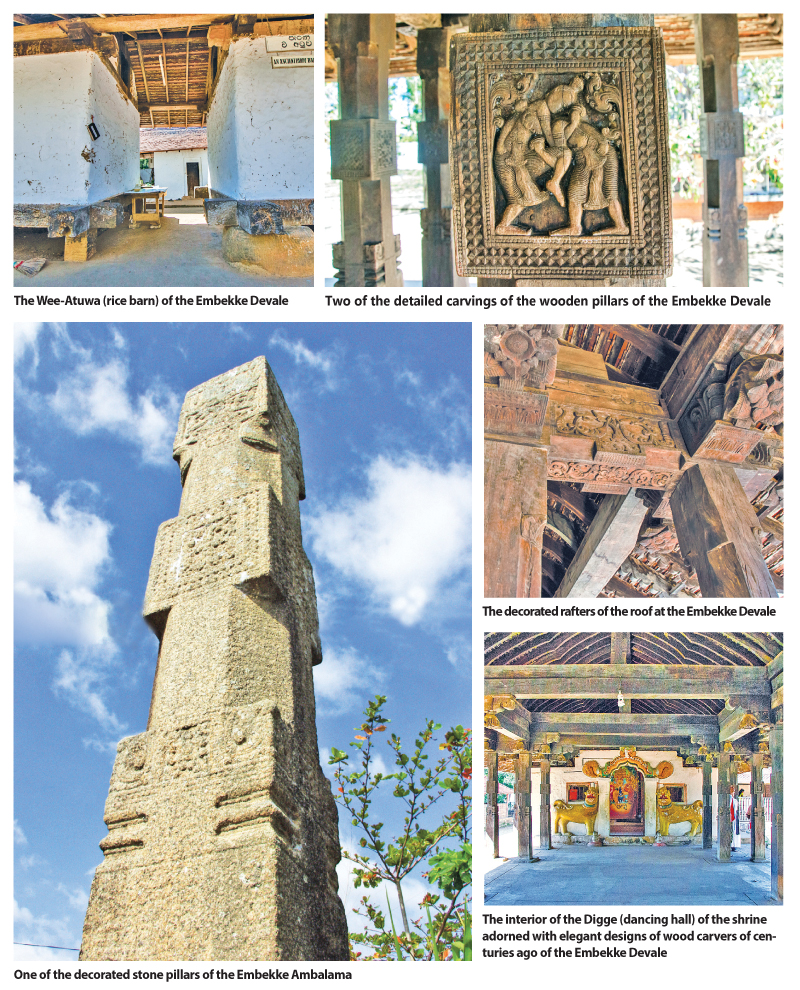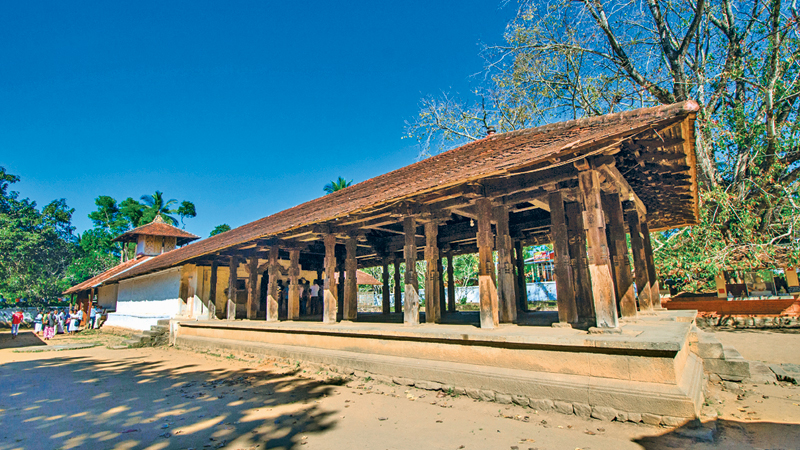The third and final destination of our detour of the Daulagala road was Embekke Devale. In the early morning sunlight we visited Gadaladeniya and Lanklatilaka and it was late morning when we arrived at the Embekke Devale.
Travelling towards Embekke, which is another two kilometres along the same road that winds through lush green fertile paddy fields and the typical rustic Embekke village, we caught a glimpse of an impressive landscape of rural Kandyan setting.
Since public transport is not available on the road that we travelled, from Lankatilaka to Embekke, we offered a lift to a boy we saw walking, to attend his tuition class in a nearby place. A villager told us that over 100 families, many of them Muslims, lived in Embekke, most depending on agriculture (rice, coffee, pepper) for their livelihood.
At the end of a street, in the warm morning sun, we saw the outline of a porch, like a large wooden gate amid a thick flank of evergreen. Its high-pitched flat tile roof was supported by dark, square wooden pillars making the entrance to one of Sri Lanka’s finest examples of medieval wooden architecture, the Embekke Devale.
We removed our shoes and put them beside the entrance and then climbed, curiously, up the few steps into the porch. There are two notice boards in the poach, one, erected by the Department of Archaeology which explains the history of the Devale.
The other tells the times of the pooja conducted at the Devale, and the veneration that takes place daily at 6.am, 11.30am and 7.pm.
Poojas
However, we missed the morning pooja and were told that except the morning pooja, the poojas later on were more impressive when pilgrims, schoolchildren and tourists were crowded into the shrine’s hall.
We saw bus loads of pilgrims who had already come and who paid sharp attention to the wood carvings, while a sarong clad, self-appointed old man at the Devale educated them about the place. Beyond the spacious compound with a Bo tree hung with colourful flags on the right, an unusual building of wattle and daub raised off the ground on the left, and an open pavilion with a regiment of wooden pillars stood in the centre.
To the right side of the sanctum is an adjoining building with twin cells whose sole occupant is a magnificent peacock on a pedestal. It was carved from a single piece of wood and the cell was kept closed all the time. The second is the Budu Ge (Image house) containing a seated Buddha statue with murals, belonging to the Kandyan period.
According to the description on the notice-board of the Archaeology Department at the site, it was a Devale of Embekke, dedicated to the worship of Mahasen, popularly known as Kataragama Deviyo. A local deity, Devata Bandara is also worshipped at the site. The shrine consists of three sections, the Garbha (sanctum), Digge (dancing hall) and the Hevisimandapaya (drummers’ hall). It is the drummers’ hall that has drawn the attention of visitors to the site, bearing splendid carvings on its ornate and high-pitched roof.
The Devale is said to have been built by King Vikramabahu III (1357-1374 AD) of Gampola. It is said that some of the woodwork utilised for the drummers’ hall came from an abandoned Royal Audience hall at Gampola. There is every possibility that the hall had been repaired during the reigns of the Sinhala kings of Kandy.
Legend
An interesting legend has interwoven with the building of the Embekke Devale. According to this, a Panikkaya named Ragama had been suffering from a skin disease and after making a vow to the Kataragama Deviyo, he had been cured. Ever since he was cured, he travelled to Kataragama annually. However, when he reached old age and on his last visit to Kataragama, he was concerned that he would not be able to travel to Kataragama anymore. That night, the Kataragama Deviyo had appeared in his dreams and asked him to perform drumming at the miracle that was to happen in a few days.
As predicted in his dream, the miracle did occur a few days after this, a Kaduru tree in the Queen’s Garden had started to bleed when the gardener tried to cut the tree. Hearing of this, the drummer went there and performed a drumming ritual and built a shrine for the Katargama Deviyo around the tree. When King Vickramabahu III hearing of this, had donated the land, the labourers and elephants to build a three-storey shrine for the Kataragama Deviyo. Queen Henakanda Biso Bandara, a consort of King Wickramabahu III also gifted her valuable jewels to the shrine.
In the Digge (dancing hall) are the sculptured panels of wood which have won fame for Embekke. The skill of the 14th century wood carvers gave life to the scenes they portray with elaborate wood carvings on the many pillars and the roof, apart from the various carvings of swans, a soldier on horse- back, a mermaid, wrestlers, a lion, a dancing girl and mythical creatures, which are considered to be among the finest woodcarvings in the world.
Wood carving
Having strolled with the pilgrims in the Digge, we mesmerised viewing the magnificent wood carvings at the Devale. Not one of the panels, at eye-level on each side of the 32 columns, is the same. The carvings which adorn the wooden pillars of the Drummers’ hall, as well as the entrance porch of the Devale are some of the best examples of wood carving of Sinhala craftsmen.
Apart from the various carvings on the columns, considered to be among the finest in the world, another striking feature in Embekke Devale is its roof.
Though it does not have a central beam, the roof reflects a cartwheel with 26 spoke-like rafts that meet at the centre of the roof, connected with a single wooden nail. We are told that this is called Madol Kurupava, a kind of giant catch-pin, the likes of which we do not have elsewhere in the country.
On the corner of the left side of the Embekke Devale is a peculiar structure erected on several monolithic rock slabs with twin rooms with white washed walls, having neither doors nor windows, that are sheltered by one flat-tiled gable roof. The visitors to Embekke would be surprised at this odd-looking building. It is in fact, the Vee-Atuwa, (rice barn) where paddy and other grain harvests offered to the Devale are stored for the use of the offerings of the Devale.
Ladders are used to reach the storerooms on either side and it is believed that it is built on a raised platform to prevent dampness. The Vee-Atuwa of the Embekke Devale is considered one of the most unique architectural features of Sri Lanka.
Adjoining the Vee- Atuwa is another small building, used as a kitchen of the Devale. As we peeped through the small door into the dimly lit kitchen, an old man with a smile, said he was a chef at the Devale. The three-time Pooja on each day, is prepared by him.
Embekke Ambalama
Most visitors to the Embekke Devale miss, too, the ruins of the Embekke Ambalama (rest hall), a royal shelter, said to have been built prior to the Devale by King Buvanekabahu IV (1341-1351AD). It is said that this Ambalama had been constructed to serve as a resting place for those involved in the construction of the Viharas at Gadaladeniya and Lankatilaka.
We saw it by chance when we followed the road below the village to Daulagala. The stone pillars measuring 2.1 metres (7ft) each stood on the flat rock under a shady tree whose branches stretch out over the stone columns. The monolithic pillars of this Ambalama contain carvings similar to those on the wooden pillars of the Devale.
There is hardly any remains of the once beautiful woodwork of the building. At one time, these unique stone pillars were in grave danger of being neglected and were overgrown with creepers.
Although the original grandeur is fast disappearing, the Department of Archaeology has undertaken its conservation strewing sands on a foundation built around the stone pillars. An annual Perahera of the Embekke Devale also takes place in Embekke every year in honour of the Kataragama Diviyo.
If you are a history buff, Gadaladeniya, Lankatilaka and Embekke – the trinity of architectural marvels of the Gampola era in the outskirts of Kandy are must visit sites with the lush green paddy-fields and unique countryside on your way, to experience the island’s glorious past.








